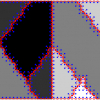Free Online Productivity Tools
i2Speak
i2Symbol
i2OCR
iTex2Img
iWeb2Print
iWeb2Shot
i2Type
iPdf2Split
iPdf2Merge
i2Bopomofo
i2Arabic
i2Style
i2Image
i2PDF
iLatex2Rtf
Sci2ools
CVPR
2009
IEEE
2009
IEEE
Angular Embedding: from Jarring Intensity Differences to Perceived Luminance
Our goal is to turn an intensity image into its perceived luminance without parsing it into depths, surfaces, or scene illuminations. We start with jarring intensity differences at two scales mixed according to edges, identified by a pixel-centric edge detector. We propose angular embedding as a more robust, efficient, and versatile alternative to LS, LLE, and NCUTS for obtaining a global brightness ordering from local differences. Our model explains a variety of brightness illusions with a single algorithm. Brightness of a pixel can be understood locally as its intensity deviating in the gradient direction and globally as finding its rank relative to others, particularly the lightest and darkest ones.
Angular Embedding | Brightness Perception | Computer Vision | CVPR 2009 | Intrinsic Images | Lightness Perception |
| Added | 09 May 2009 |
| Updated | 10 Dec 2009 |
| Type | Conference |
| Year | 2009 |
| Where | CVPR |
| Authors | Stella X. Yu |
Comments (0)

